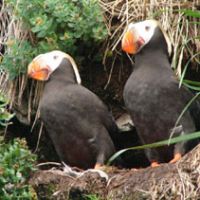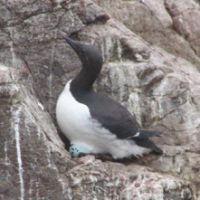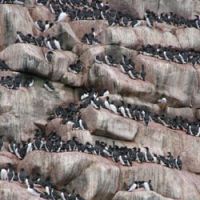It is August already, and it's a matter of life and death for certain seabirds. While southern species will already have run the gauntlet of the gulls, in the north it's happening now.
On clifftops and rock stacks, great pyriform eggs, patterned and blotched in intricate and delicate dark patterns against backgrounds of blue, green, dull red or cream, lying singly on bare nestless rock, have been crouched over and incubated for at least a month. Cracking from within; pecked and pushed by the young chick inside, a window to the sky opens. Out sprawls a fluffball. Proud Common Guillemot (Common Murre to any North American readers) parents stand by, their hard work over. But now it really gets tough.
Before: Two hungry adults, each at least 5 years old, commuted between precipitous cliff and foraging grounds, taking turns to incubate and to feed themselves. Great gulls, strong-winged and heavy-billed, hung on the wind watching, waiting. Any egg left unattended was their prey. Then: A third hungry mouth begs for food; harried parents whir to and fro, stiff wings blurring, needing food themselves and extra for their single youngster. But the little fluffball left alone for a moment provides another opportunity for the gulls. The risks never cease.
Growing fast, but not rapidly enough, the chick nears a precipice. Time, weight, height, the gulls; all are pressing in on a youngster as yet unable to fly. Although still flightless at about 20 days past hatching, the youngster on the high ledge is a liability. The female is exhausted. It's the male's turn. He growls from the ocean below; his calls sound like a dog clearing its throat, like a tongue-rolling exercise: "Morrrrrr." The chick waits for food, begging. The male waits for the chick on the ocean below, growling. Over the cacophony of the ocean, over the sounds of the swell, the rush of the waves against the cliff base, over the calls of thousands of other birds, the calls of this male draw its chick. It's do or die time. Do and die time for some.
The gulls are waiting too. Menacing, dark-winged Slaty-backed Gulls appear piratical. Further north, silver and white-winged Glaucous Gulls seem almost angelic from a distance. Up close that look is belied by their massive beak, and their marauder's stare. Slaty-backed or Glaucous; they watch and wait, gliding along the cliffs awaiting an opportunity to pounce.
With no preliminaries the chick plunges: In a seeming death-wish bungee-jump without a rope, it tumbles. Still light enough to defy death — like a falling kitten — nevertheless each impact seems that it should be fatal. Wings too short, too weak, too undeveloped to support its weight (even its parents struggle to become airborne), it beats them in a frenzy. Crashing, tumbling, bouncing; finally splashing and bobbing, it makes its way toward its father. An ill-timed jump; a crash-landing behind a boulder, not in front, or into a crevice, and its fate is sealed. The ever-watchful gulls swoop from above. Snatch, gulp; there is a moment when only the chick's feet remain visible, then all is gone, head first, in one swallow into the bulging crop of the gull.
What the gulls miss, the foxes find. Red Fox, Arctic Fox, each forages in the same way. This is the season of plenty. For them the cliff is a delivery service. Manna rains from above. They patrol where the cliff meets the beach, scrabbling, climbing where they can, sniffing, pouncing, biting.
It is an exodus. The rain of chicks continues for days; the gulls wheel; the foxes pace. Each chick is a summer's worth of investment for its parents. Each chick is merely one meal for a predator. This is a scene of life and death in morbid black, white and gray; but here and there is a splash of color. Brilliant vermilion feet on a black bird indicate a Spectacled Guillemot, or further north a Pigeon Guillemot (black with white wing patches). Orange indicates the presence of a Puffin, comical with enormous bill and orange feet.
Puffins, guillemots, murres; each play out the summer in their own way, but all are drawn to the same place. Safety in numbers, isolation, access to feeding grounds; all of these mean islands. Islands without rats! The Spectacled and Pigeon guillemots nest closer to the water, in among rock jumbles. No exposure for their eggs or chicks — not until final emergence and the rush to the sea. Puffins too. Stout, solid, stalwart; excavators. Hobbits of the bird-world; they burrow. Beak and claw scrape and dig. Hidden beneath the turf, deep in fibrous soil atop the cliff, their single white egg is safe. Adults run the same gauntlet though. At the very least an effortlessly gliding gull may grab a wing-whirring Puffin by its wingtip in flight. A tug, and the barely airworthy Puffin tumbles, disgorging its hard-won food to the gull in its bid to escape.
It's a madhouse. Everywhere whirring wings; the air filled with noise. From below — the sea. From above — the birds; like the noisy hubbub of a theater audience moments before the curtain rises. Walls of sound echo off walls of rock in a deafening, ceaseless: "kitt-ea-wake" "kitt-ea-wake," growling "morrrr" "morrrr," and the shrill, whistled piping of the various seabirds.
Now: the focus is moving. Where the cliff colony was spring and summer, the ocean is autumn and winter. The blizzard of wings is thinning, the sound wall is diminishing, the theater curtain is rising — but onto an emptying stage whose characters are fleeing outward. Where millions of wings blurred the cliffside scenery, the view is clearing. Now, the colony resembles a battlefield; broken eggs, mangled chicks, the injured, the dead; hope remains only for the gulls and the foxes — until next year.
The great pendulum of life is swinging, a pulse of life bursts onto the stage in the north during the brief summer. For a while all is buzz and roar, whir and crash. Then the pulse reaches its zenith, begins to fade and then, like a slow-throbbing heart, it waits for the coming of another summer. Meanwhile the seabirds have temporarily broken their ties to the land (only the drive to procreate will bring them back again). For the months ahead, the open ocean is their domain (and their demise); as if its natural hazards were not enough to daunt them, they are increasingly hemmed in by nets, at risk of entanglement each time they dive for food. Discarded oil can fatally cloak them, too, while our buoyant trash can choke them.
How many will return next summer when the pulse of life hastens them toward another breeding season?
Mark Brazil is a naturalist and author with a fascination for life in all its forms and the questions that it raises. Mark leads naturalists around the world for Zegrahm and Eco-Expeditions. His first book, "A Birdwatcher's Guide to Japan," is now out of print, but Mark has some mint-condition signed copies available for sale. If interested in a personally dedicated copy please e-mail: [email protected]





